Rounding out the initial quartet of Xbox Studio titles announced for PlayStation 5, miniature survival game Grounded has arrived on Sony’s machine – and Nintendo Switch too. Given that we last looked at Grounded in early access on Xbox One and PC way back in 2020, these two new releases give us a perfect opportunity to reappraise all platforms today. And so, here we’ve got PS5, Switch, Series X, Series S and PC in focus, as we see how all compare in terms of fidelity and performance. Most importantly, does the PS5 edition recreate the Series X experience, or are there graphics changes as we saw in Hi-Fi Rush on its PS5 debut? And for Switch, how does its handheld play actually hold up with 30 frames per second as the target?
For the uninitiated, Grounded is a survival game in the mould of Valheim or Ark: Survival Evolved that lets you loose on a garden after being shrunk down to the size of a figurine. You wake up to a jungle of looming grass blades, evade spiders, navigate all manner of discarded gadgets and junk, scavenge for food, and above all – through the power of science – seek a way to return to your normal size. The central conceit calls to mind Andy’s garden from Pixar’s Toy Story, or even Disney’s comedy adventure Honey, I Shrunk the Kids.
It’s a great survival-themed backdrop – deploying heavy bokeh depth of field to truly sell the scale of its world. We’re not getting an all-guns-a-blazing showcase for Unreal Engine here by any means. But still, it’s a fun idea with solid execution, featuring a day-night cycle plus some beautiful volumetric lighting effects. Impressively, these latest ports to PS5 and Switch also include cross-play by linking to a Microsoft account, so up to four friends across multiple platforms can combine forces to build structures and survive the creatures of the garden.
Let’s get straight to the comparisons then, with a focus on PS5 first. For such a simplistic game stylistically you’d hope for close parity with Series X, but there are a few differences – starting with a different target resolution. On PS5 we’re getting a dynamic range between 1080p and 1215p, which is the most typical number. That means a softer image than on Series X, which itself ranges from 1512p up to 4K but is more often at the lower end. Looking at the same scene side-by-side, PS5 is often at a resolution disadvantage – for example 1620p on Series X versus 1215p on PS5 in one matched frame test. That’s an unusually wide divide that did warrant a lot of repeat testing to confirm, but it does seem to be consistent.
Series S takes another step backward in resolution, targeting 1080p as its maximum figure, with dynamic resolution scaling to just under 1080p – around 1026p – with little deviation under. It’s a conservative target for the 4TF machine really, though 1920×1080 is acheived fairly consistently.
The lower range of PS5’s dynamic resolution is strange, especially given the state of its frame-rate – which I’ll get to shortly. Otherwise, it’s worth stressing that most other visual settings – with a few exceptions – are identical. Shadow map LODs, texture quality and effects are all matched between PS5, Series X and even Series S. Curiously though, geometry LODs run at a higher setting on PS5 overall, meaning items draw in further ahead. Series X renders small objects at a slight delay by comparison, closer to the screen, while Series S is closer still with more obvious object pop-in.
Attribution
That brings us to point number three: the shadows. There’s a difference in the presentation of shadows on PS5 and Series X, which echoes Oliver’s mixed findings in his Sea of Thieves tech analysis – another Unreal Engine title ported to PS5. It’s not clear what precisely is causing the difference either.
Two huge potential factors are the base shadow resolution and the shadow filtering applied over the top. Looking at interior shadows to start, Xbox Series X and Series S use the same setting between them – which, by the way, is a match for PC’s high setting. But then there’s PS5, which uses sharper and more cleanly defined shadow outlines overall. The setting used on PS5 seems to be above that of Series X (high on PC) but below the highest setting (epic) on PC. Looking at all four PC shadow settings side-by-side, low and medium are a huge step down, so opting for high or epic makes sense for console.
However, this isn’t a clear-cut advantage for PS5 over Series X. Grounded is an unusual game in that shadow casting occurs from so many different altitudes, from blades of grass and small creatures to more gargantuan oak trees and human houses. In every case, shadow filtering is necessary to reduce aliasing and noise on the resulting shade. And it’s this shadow filtering setting – above all else – that appears to be creating different results between PS5 and Series X. If we switch between the two consoles, shadows cast from grass blades overhead are sharper on PS5, with more detail and definition.
Conversely though, Sony’s machine suffers from extra aliasing on shadow lines cast from high above, with the turnout on Series X being pleasingly softer without any visible stair stepping. In terms of character shadows, PS5 also produces much more aliasing, with more visual noise and flicker evident as our character sways on the spot. Series X by comparison has a more diffuse outline, but the advantage of its heavier filtering method is that it hides the visual noise of the raw, base shadow outline. Then again, to confuse matters this PS5 approach – with more visual noise – is a direct match for PC’s epic setting.
The shadow situation shows a mixture of fortunes depending on the console, then. In some cases, PS5 might be a preference, while in others the Series X approach works better. Beyond that, it’s worth noting a few other differences. The game’s distinctive bokeh depth of field is impacted by the different native resolutions on PS5 and Series X. Given it’s a post-processing effect, the detailing varies across out-of-focus points in the frame based on the overall resolution, and Series X often produces a cleaner effect. You get less aliasing on the fringes of grass blades, for example, where they intersect with the depth of field – which is more of an issue on PS5 and Series S.
Beyond the object LODs, shadows and the resolution though, the three machines are very close in world detail settings. The only final thing of note is that Series S is being marked out as a 1080p machine once again in terms of its HUD. The user interface and text are all presented at 1080p on Series S, where PS5 and Series X bump these to 4K.
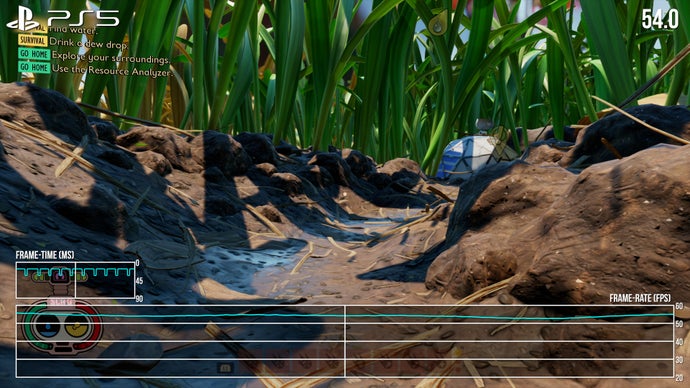
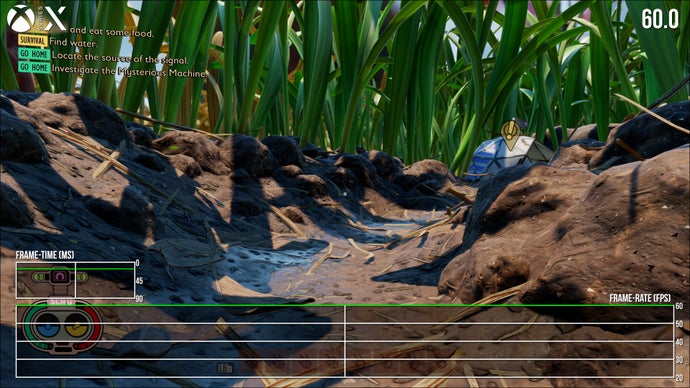
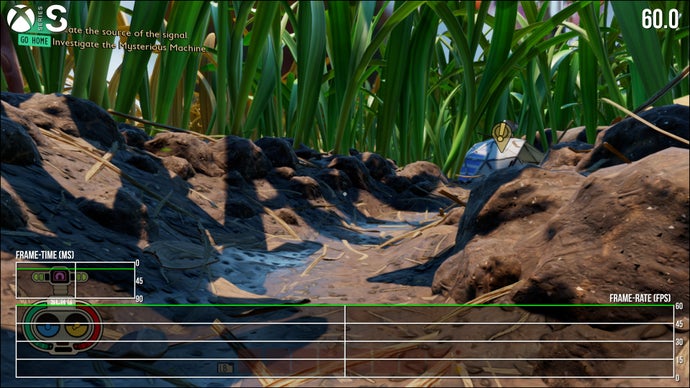
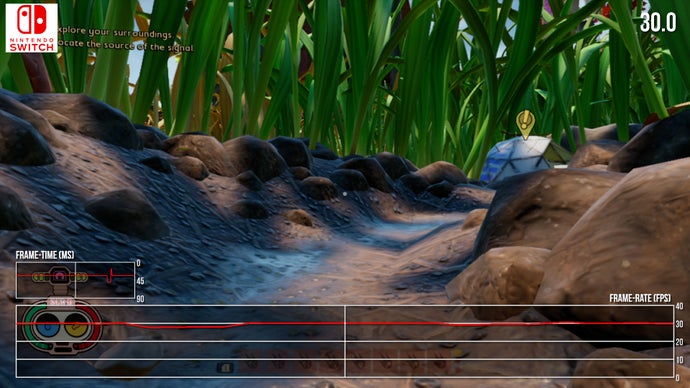
We’ll get to the Nintendo Switch in a second, but first here are the frame-rate results for the current-gen Sony and Microsoft consoles. Xbox Series X is a solid 60fps throughout, barring occasional one-frame drops and the odd hitch while auto-saving kicks in. Unfortunately, this 60fps update rate is marred by perceptible judder, which I’m attributing to irregular camera update intervals.
The same goes for Series S, with the drop in LODs and the lower dynamic 1080p resolution resulting in a stable 60fps line – with even less frequent one-frame drops when picking up an item. Bizarrely, Series S might be the smoothest version of the current-gen consoles overall, but not by a huge margin over Series X. It simply avoids some of the small one frame blips while navigating the world. All round, and barring the camera judder, both Xbox machines are nicely tuned ways to enjoy Grounded as you’d hope from a first-party release.
Switching to PS5 we see a very different result. On its latest patch 1.02, we’re getting a 60fps line in parts, but too often we see it plummeting into the 50s or as low as 45fps. It depends on the complexity of the scene of course, and the time of day is a factor too. In tracing through all the same steps as the Xbox consoles, there’s no question PS5 struggles to hit the top mark: rather than odd blips, these are proper sustained drops across segments of the garden. Players without a VRR compatible display will notice the lurches to 50fps quite easily, though VRR will smooth this over if you have it.
Attribution
As to why drops are so frequent on PS5, the cause isn’t clear. The trade-off between visual quality – bearing in mind PS5’s lower average resolution than Series X – doesn’t quite stack up. Partly this might be due to other settings differences, such as the higher object LOD preset or its higher quality shadows. Potentially there are other, more minute differences across the world in PS5’s favour. Still, it’s a surprise to see PS5 so regularly bouncing between 50 and 60fps, and it’s in need of better optimisation clearly – a better balance between visuals and performance.
Putting PS5 aside, let’s see the situation with Grounded on Nintendo Switch. Of course, it would be unfair to expect anything close to a dedicated home console in visual quality on what is realistically a handheld machine. To that end, just about every setting is dropped to suit the Tegra X1 chipset’s limits, including a 30fps target frame-rate rather than the 60fps we see on other current-gen machines.
The resolution while docked or handheld runs at between 720p and 360p – though 600p is the typical number in regular docked play, with lower figures in handheld mode. The install profile of the game is reduced to just 3.1GB on Switch too – a third of the install size on PS5 or Series X. There’s a lot of crunching down of asset quality going on here: texture resolution is lowered across the garden to fit into the Switch’s limited 3.5GB of usable RAM. Even versus Series S, there’s more pop in for textures, grass, geometry and shadows. Other effects are removed entirely, from depth of field and motion blur to volumetrics and light shafts. Character self-shadows are removed too, evident while looking down at your feet, and decorative detail is reduced up close, meaning fewer rocks and leaves strewn across the ground.
Grounded’s presentation on Switch takes a radical hit then, and it does look rough when it hits that minimum 360p resolution in docked play on a 4K display. Fundamentally, PS5, Series X, S and PC are all significantly better choices for a big screen experience. To Switch’s credit, this version does keep the core framework of the garden in place: including a day/night cycle, the physics of swaying grass blades and screen space reflections on water. Of course, the structure and mechanics are mirrored with PS5 and Series X for cross-play purposes, even if surface level details – like shadow draw and textures don’t match up. It’s certainly not pretty – the texture pop-in sticks out like a sore thumb, and often you need to be within touching distance to see a fully loaded texture. The initial loading time is also lengthy at over a minute.
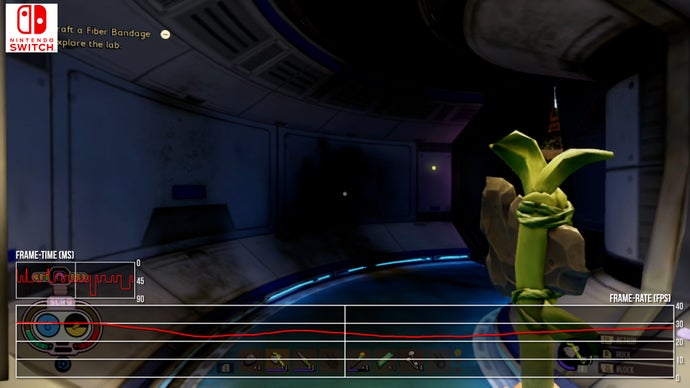
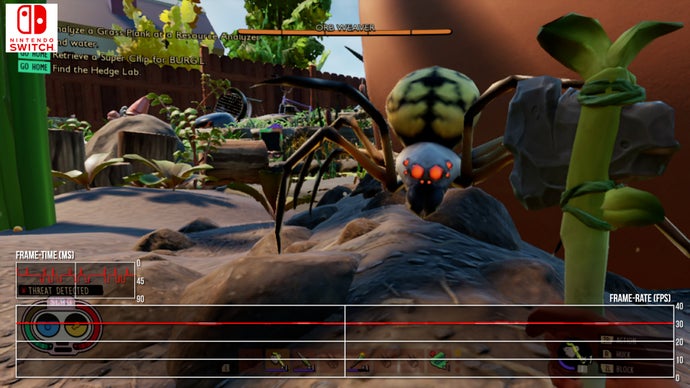
The final test is how well Switch manages to hit its 30fps target. Right off the bat, it’s clear that our eternal nemesis – uneven frame-pacing – has returned. Even at a decently solid 30fps lock, the frame-times are all over the place, with traversal stutters causing more noticeable hang-ups in play as assets stream in. CPU contention and memory bandwidth are typical bottlenecks on Switch for complex open worlds, and it stands to reason those are the culprits for hitches here. On top of that we have auto-save stutters, which are more sizeable than PS5 and Series X and therefore you might consider making these save points less frequent via the options menu (where it is thankfully adjustible). In terms of actual sustained GPU-side drops on Switch, Grounded runs well 95 percent of the time… but our first encounter with the lab under the oak tree drags us well into the 20s. It’s tough to navigate through the rickety frame-times here, though thankfully these areas seem few and far between.
Grounded’s introduction to PS5 and Switch isn’t a smooth one then, and especially running on Sony’s latest hardware, the slipshod performance on PS5 is hard to excuse. Running between 45 and 60fps, with worse image quality than on Series X, albeit with higher settings elsewhere, is far from an optimal balance. So many Xbox Game Studios titles landing on PS5 have done so with unusual differences – like the differing shadows in Hi Fi Rush – but at least performance has been equivalent. For Grounded though, in a cross-play game between a PS5 and Series X, I know which one I’d rather play right now.
Looking at Switch meanwhile, the inherent limits of the hardware put it in a different league to those top-end machines. As ever it’s fascinating to see how it works, purely as an academic exercise – to see if it can be done. The many visual cutbacks do mean we get to 30fps, but realistically, as a way to enjoy Grounded in the long-term, it’s a hard one to really recommend. At a push, playing on Switch’s smaller screen might help hide some of its issues, though it’s an uphill battle to enjoy the game with uneven frame-times and heavy pop-in. For now then, I’d suggest the best optimised Grounded experience is still on Xbox Series X, Series S and PC.
